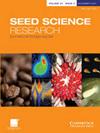春化使农业杂草Alopecurus myosuroides (Huds.)的种子休眠。
IF 1.9
3区 生物学
Q2 PLANT SCIENCES
引用次数: 0
摘要
种子休眠是田间杂草出苗模式的关键因素。黑草(Alopecurus myosuroides)是欧洲一种严重的谷物杂草,它经历了两个出苗期,分别影响冬季和春季谷物。秋天发芽的幼苗会经历一段寒冷的冬季,而春天发芽的幼苗则不会。在这项工作中,我们研究了营养生长期间这种越冬对后代初级种子休眠的影响。在控制条件下,将一部分人口作为幼苗进行模拟冬季(春化)繁殖。春化植株产生的后代休眠时间明显更长,需要更长的成熟后和冷分层处理才能在温暖的温度下发芽。然而,休眠种子发芽的温度范围没有差异。我们假设这种休眠的差异是春化的表观遗传记忆的结果。使用基于elisa的方法定量种子DNA甲基化的全局变化。春化植物产生的休眠种子的吸胀与全局去甲基化事件有关,而在未春化植物的后代中没有观察到这一事件。综上所述,这些结果表明温度在植物生命周期的不同阶段对决定休眠水平和田间杂草出现模式的重要性。本文章由计算机程序翻译,如有差异,请以英文原文为准。
Vernalization enforces seed dormancy in the agricultural weed Alopecurus myosuroides (Huds.)
Seed dormancy is the key factor determining weed emergence patterns in the field. Alopecurus myosuroides (black grass) is a serious cereal weed in Europe that experiences two emergence peaks affecting winter and spring cereals, respectively. Seedlings that emerge in autumn encounter a period of cold winter temperatures, whereas those that emerge in spring do not. In this work, we investigated the effects of this overwintering during vegetative growth on the primary seed dormancy of the offspring. Alopecurus myosuroides plants were propagated under controlled conditions where a proportion of the population was subjected to a simulated winter period (vernalization) as seedlings. The offspring produced by vernalized plants was significantly more dormant, requiring longer after-ripening and cold stratification treatments to germinate at warm temperatures. However, there was no difference in the range of temperatures under which dormant seeds germinated. We hypothesized that this difference in dormancy was the result of an epigenetic memory of vernalization. Global changes in DNA methylation of seeds were quantified using an ELISA-based approach. Imbibition in dormant seeds produced by vernalized plants was associated with a global demethylation event that was not observed in the offspring of plants that had not been vernalized. Taken together, these results demonstrate the importance of temperature at different stages of the plant lifecycle in determining dormancy levels and consequently weed emergence patterns in the field.
求助全文
通过发布文献求助,成功后即可免费获取论文全文。
去求助
来源期刊

Seed Science Research
生物-植物科学
CiteScore
3.60
自引率
4.80%
发文量
23
审稿时长
>12 weeks
期刊介绍:
Seed Science Research, the official journal of the International Society for Seed Science, is a leading international journal featuring high-quality original papers and review articles on the fundamental aspects of seed science, reviewed by internationally distinguished editors. The emphasis is on the physiology, biochemistry, molecular biology and ecology of seeds.
 求助内容:
求助内容: 应助结果提醒方式:
应助结果提醒方式:


